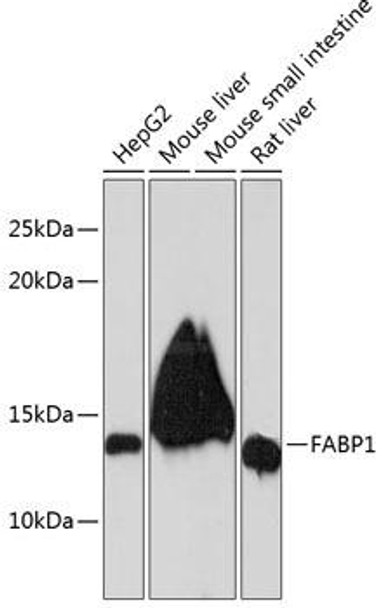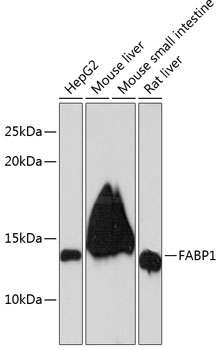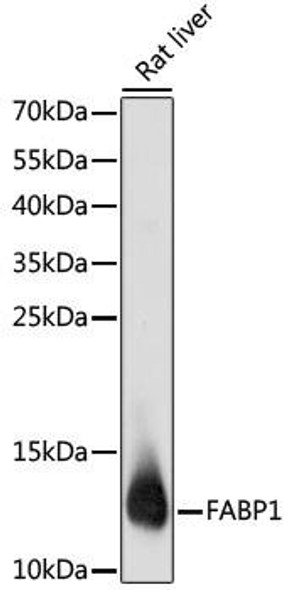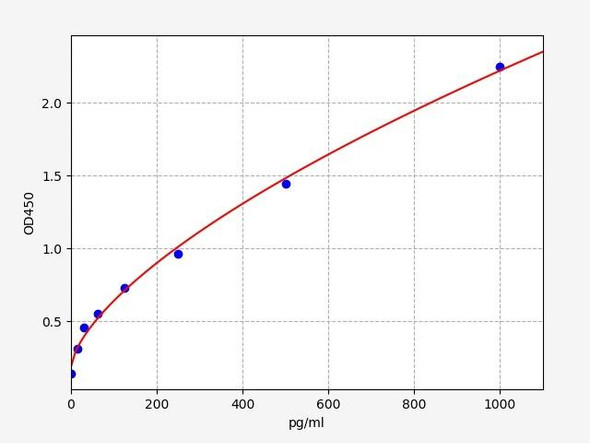Anti-FABP1 Antibody (CAB11213)
- SKU:
- CAB11213
- Product type:
- Antibody
- Reactivity:
- Human
- Mouse
- Rat
- Host Species:
- Rabbit
- Isotype:
- IgG
- Antibody Type:
- Monoclonal Antibody
- Research Area:
- Signal Transduction
Frequently bought together:
Description
| Antibody Name: | Anti-FABP1 Antibody |
| Antibody SKU: | CAB11213 |
| Antibody Size: | 20uL, 50uL, 100uL |
| Application: | WB IF |
| Reactivity: | Human, Mouse, Rat |
| Host Species: | Rabbit |
| Immunogen: | A synthesized peptide derived from human FABP1 |
| Application: | WB IF |
| Recommended Dilution: | WB 1:500 - 1:2000 IF 1:50 - 1:200 |
| Reactivity: | Human, Mouse, Rat |
| Positive Samples: | HepG2, Mouse liver, Mouse small intestine, Rat liver |
| Immunogen: | A synthesized peptide derived from human FABP1 |
| Purification Method: | Affinity purification |
| Storage Buffer: | Store at -20°C. Avoid freeze / thaw cycles. Buffer: PBS with 0.02% sodium azide, 0.05% BSA, 50% glycerol, pH7.3. |
| Isotype: | IgG |
| Sequence: | Email for sequence |
| Gene ID: | 2168 |
| Uniprot: | P07148 |
| Cellular Location: | |
| Calculated MW: | 14kDa |
| Observed MW: | 14KDa |
| Synonyms: | FABPL, L-FABP |
| Background: | This gene encodes the fatty acid binding protein found in liver. Fatty acid binding proteins are a family of small, highly conserved, cytoplasmic proteins that bind long-chain fatty acids and other hydrophobic ligands. This protein and FABP6 (the ileal fatty acid binding protein) are also able to bind bile acids. It is thought that FABPs roles include fatty acid uptake, transport, and metabolism. [provided by RefSeq, Mar 2011] |
| UniProt Protein Function: | FABP1: Binds free fatty acids and their coenzyme A derivatives, bilirubin, and some other small molecules in the cytoplasm. May be involved in intracellular lipid transport. Belongs to the calycin superfamily. Fatty-acid binding protein (FABP) family. |
| UniProt Protein Details: | Protein type:Lipid-binding Chromosomal Location of Human Ortholog: 2p11 Cellular Component: nucleoplasm; peroxisomal matrix; apical cortex; cytosol Molecular Function:antioxidant activity; bile acid binding; phospholipid binding; long-chain fatty acid transporter activity; chromatin binding; drug binding; fatty acid binding Biological Process: long-chain fatty acid transport; positive regulation of cell proliferation; positive regulation of hydrolase activity; cellular lipid metabolic process; negative regulation of caspase activity; negative regulation of apoptosis; positive regulation of fatty acid beta-oxidation; intestinal absorption |
| NCBI Summary: | This gene encodes the fatty acid binding protein found in liver. Fatty acid binding proteins are a family of small, highly conserved, cytoplasmic proteins that bind long-chain fatty acids and other hydrophobic ligands. This protein and FABP6 (the ileal fatty acid binding protein) are also able to bind bile acids. It is thought that FABPs roles include fatty acid uptake, transport, and metabolism. [provided by RefSeq, Mar 2011] |
| UniProt Code: | P07148 |
| NCBI GenInfo Identifier: | 119808 |
| NCBI Gene ID: | 2168 |
| NCBI Accession: | P07148.1 |
| UniProt Related Accession: | P07148 |
| Molecular Weight: | 127 |
| NCBI Full Name: | Fatty acid-binding protein, liver |
| NCBI Synonym Full Names: | fatty acid binding protein 1, liver |
| NCBI Official Symbol: | FABP1 |
| NCBI Official Synonym Symbols: | FABPL; L-FABP |
| NCBI Protein Information: | fatty acid-binding protein, liver; fatty acid-binding protein 1; liver-type fatty acid-binding protein |
| UniProt Protein Name: | Fatty acid-binding protein, liver |
| UniProt Synonym Protein Names: | Fatty acid-binding protein 1; Liver-type fatty acid-binding protein; L-FABP |
| Protein Family: | Fatty acid-binding protein |
| UniProt Gene Name: | FABP1 |
| UniProt Entry Name: | FABPL_HUMAN |






